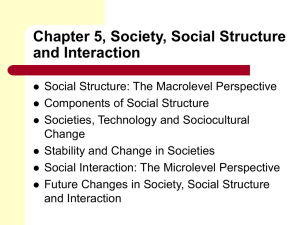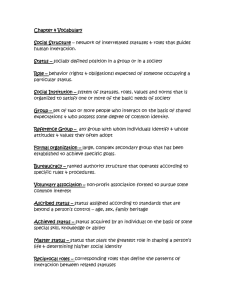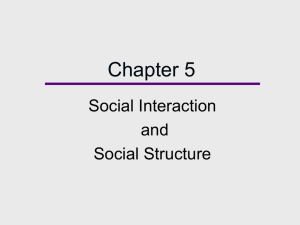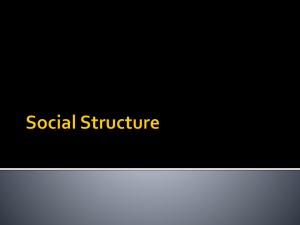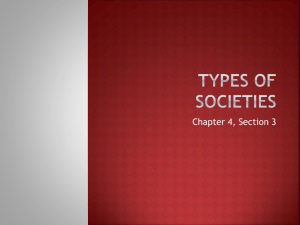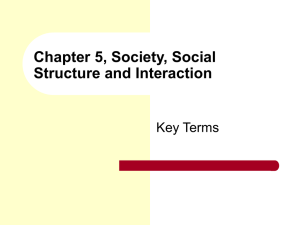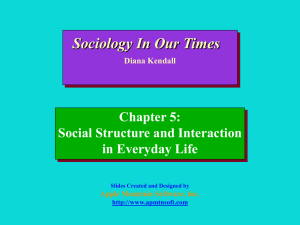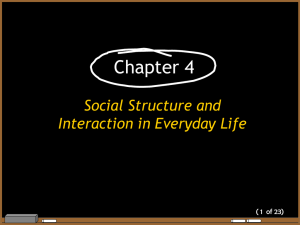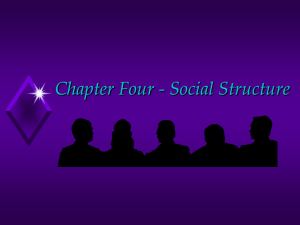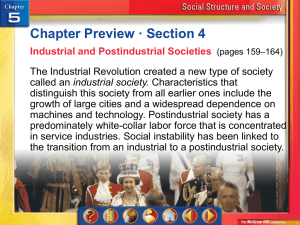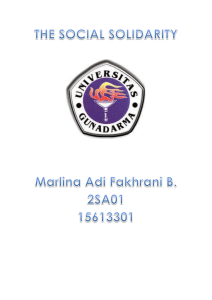170-chapter5
advertisement
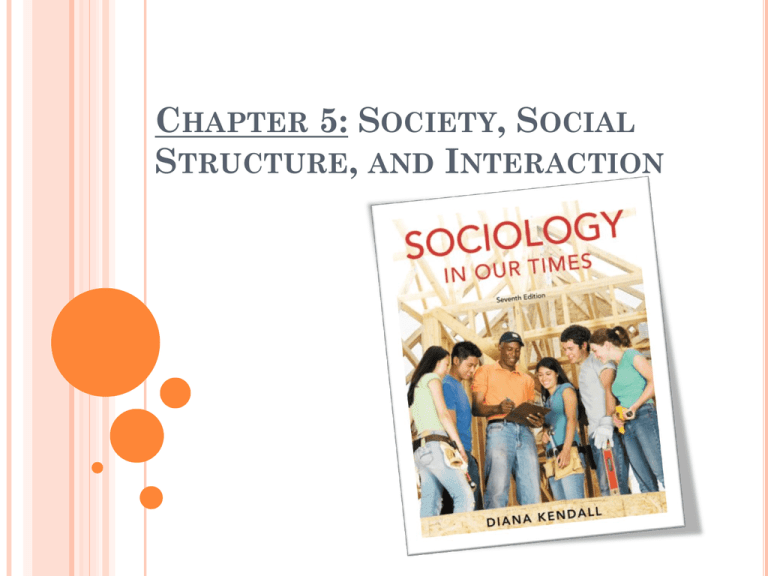
CHAPTER 5: SOCIETY, SOCIAL STRUCTURE, AND INTERACTION SOCIAL STRUCTURE: MACRO-LEVEL The complex framework of societal institutions, and the social practices that make up a society and organize/ establish limits on people’s behavior Politics as an institution, with laws and roles as social practices Social structure helps us make sense of our environment, like a map for our endeavors It also creates boundaries, or groups, that include/exclude certain individuals Social Marginality (Coined by Robert Park) Social Marginality results in stigmatization, or attributing symbols that devalue a person’s social identity SOCIAL STRUCTURE: FRAMEWORK SOCIETY Social Institutions Traditional • Family • Religion • Education • Government • Economy Statuses And Roles Emergent • Sports • Mass Media • Science/Medicine • Military Ascribed Status • Race/Ethnicity • Age • Gender • Class Social Groups Primary Groups • Family Members • Close Friends • Peers Secondary Groups • Schools • Churches • Corporations Achieved Status • Occupation • Education • Income Level A Status is a socially defined position in a group or society, characterized by certain expectations, rights, and duties To determine who you are, you derive your identity from the status you occupy One’s status is the closest position to the individual; as it is the most personal, or microscopic, on the social structure scale There are two types of statuses, ascribed and achieved Ascribed is a social position conferred at birth, or is received involuntarily based on attributes the individual has little to no control of; such as race, age, gender, physical features, etc. Achieved is a social position that a person assumes voluntarily as a result of personal choice, merit, or direct effort; such as profession, wife, volunteer, etc. A Master Status refers to the most important status to the individual (Coined by Everett Hughes:1945) Certain material symbols can also signify status Like owning a Rolls-Royce, or designer clothes, jewelry, etc. STATUSES A role is essentially a status in play; it is the dynamic, or the active component of the status (We may occupy a status, but we play a role) Role expectation is a group’s or society’s definition or the way that a specific role ought to be played Whereas role performance is how the person actually performs the role Role conflict, strain, and exit Role Conflict occurs when incompatible role demands are placed on a person by two or more statuses held at the same time Role Strain occurs when incompatible demands are built onto a single status that the person occupies The performing of multiple roles often results in role conflict, like mixing personal and professional life Work inequality, occupation, and sexual orientation are often associated with role strain Role Exit occurs when people disengage from social roles that have been central to their self Complementary and Ambiguous roles Complementary roles refer to the existence of the role in context of others, i.e. for you to be a professor you must have students (who themselves accept the role of student) • ROLES A Role is a set of behavioral expectations associated with a given status One is expected to behave differently when considering income differences for instance Ambiguous roles occur when role expectations become unclear, or have indefinite answers • For example: When do the parents definitively stop supporting the child? (financially) GROUPS A Social group consists of two or more people who interact frequently and share a common identity and a feeling of inter-dependence Primary group Secondary group Is a small, less specialized group in which members engage in faceto-face, emotion based interactions over an extended period of time Is a larger, more specialized group in which members engage in more impersonal, goal-oriented relationships for a limited period of time A formal organization is a highly structured group formed for the purpose of completing certain tasks or goals Social solidarity refers to a group’s ability to maintain itself in the face of obstacles. Things like social bonds, attractions, and forces hold the members in interaction over a period of time. More In-depth in Chapter 6: Groups and Organizations SOCIAL INSTITUTIONS A Social Institution is a set of organized beliefs and rules that establishes how a society will attempt to meet its basic and social needs All societies undergo similar processes, but with the onset of the modern era, there are additional institutions; such as, mass media, science and medicine, and the military Functional theorists emphasize that social institutions exist because they perform five essential tasks 1) 2) 3) 4) 5) Replacing members Teaching new members Producing, distributing, and consuming goods Preserving order Providing and Maintaining a sense of purpose SOCIETIES, TECHNOLOGY, AND SOCIOCULTURAL CHANGE Hunting and Gathering Control of Surplus Inheritance Industrial Post-industrial Animal drawn plows and equipment Invention of steam engine Computer and “hightech” society Hunting game, gathering roots and berries Planting crops, domesticating animals Laborintensive farming Mechanized production of goods Information and service economy None Men begin to control societies Men who own land or herds Men who own means of production Corporate shareholders, and high-tech entrepreneurs None Sharedpatrilineal and matrilineal Patrilineal Bilateral Bilateral None Increasingly by men Men- to ensure legitimacy of heirs Men- but less so later in this stage Mixed Relative equality Decreasing into pastoralism Low Low Varies by class, race, and age Control over Procreation Women’s Status Agrarian Use of hand tools, primitive farming Change from prior society Economic System Horticultural and Pastoral DURKHEIM ON SOCIAL SOLIDARITY Emile Durkheim believed that the social solidarity of societies rested on the division of labor The division of labor refers to how the various tasks of a society are divided up and performed He categorized societies as having either mechanical or organic solidarity Mechanical Solidarity is the social cohesion of preindustrial societies, in which there is minimal division of labor and people feel united by shared values and common social bonds Because people more or less have a sense of automated belonging with little specialization required to perform tasks Organic Solidarity is the social cohesion found in industrial (and perhaps post-industrial) societies, in which people perform very specialized tasks and feel united by their mutual dependence Because the laborers rely on one another to function, like a living beings organs, they rely on practical considerations instead of moral considerations TÖNNIES ON SOCIAL SOLIDARITY Ferdinand Tönnies used the terms Gemeinschaft and Gesselschaft to characterize the degree of social solidarity in societies Gemeinschaft is a traditional society in which social relationships are based on personal bonds of friendship and kinship and on inter-generational stability Literally translated as “commune” or “community” Gesselschaft is a large, urban society in which social bonds are based on impersonal and specialized relationships, with little long-term commitment to the group or consensus on values Literally translated as “association,” as in based on achievement not social basis SOCIAL INTERACTION: MICRO-LEVEL PERSPECTIVE Social Interaction and Meaning Social Construction of Reality Ethno-methodology Dramaturgical Analysis Sociology of Emotions Nonverbal Communication In a given society, forms of social interaction have shared meanings, although these may vary to some extent based on race/ethnicity, gender, and social class. The process by which our perception of reality is largely shaped by the subjective meaning that we give to an experience. Studying the commonsense knowledge that people use to understand the situations in which they find themselves makes us aware of subconscious social realities in daily life. • Used by Garfinkel, typically used breaching experiments to uncover realities The study of social interaction that compares everyday life to a theatrical presentation– it includes impression management (people’s efforts to present themselves favorably to others). • Used particularly by Goffman We are socialized to feel certain emotions and we learn how and when to express (or not express) them. The transfer of information between persons without the use of speech, such as by facial, expressions, head movements, and gestures. REFERENCES AND ACKNOWLEDGEMENTS o o o Sociology In Our Times (Seventh Edition) o By: Diana Kendall Notes incorporated o By: James V. Thomas, NIU Professor (Emeritus) o Formatted By: Jacob R. Kalnins, NIU student Pictures Incorporated o Clip Art (PowerPoint: 2007) o Google Images: Sociology In Our Times
